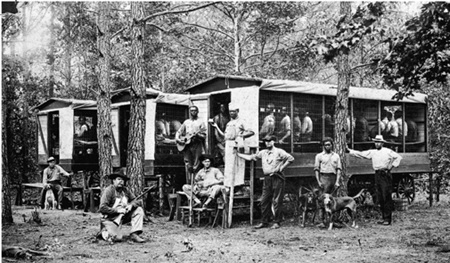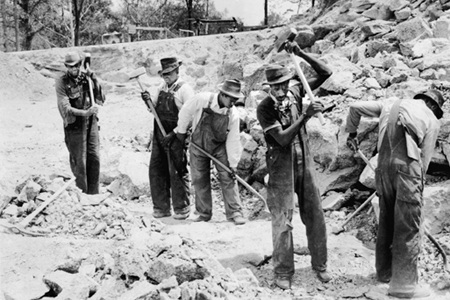Read Slavery by Another Name Online
Authors: Douglas A. Blackmon
Slavery by Another Name (38 page)
Barracks at Slope No. 12 mine for forced laborers acquired by
Tennessee Coal, Iron & Railroad Company.
African Americans forced to help build river levees, probably in
Mississippi in the 1930s. Photographer unknown.

Convict wagons like these in Pit County, North Carolina, 1910,
were used across the South to transport and house African
Americans compel ed to work in road gangs, lumber camps, and
farms.

Black prisoners at work in a rock quarry, most likely in the early
1940s. Photographer unknown.
VI
THE INDICTMENTS
"I was whipped nearly every day."
In early May, a federal grand jury, the only province of the legal
system in which African Americans could stil participate in the
South, was impaneled in Montgomery to take up the mounting
evidence of slavery in Alabama. The jury of twenty-three, composed
of twenty whites and three blacks, filed into the elegant federal post
o ce and courthouse—with arched brick doorways and an
imposing square tower at the corner of Dexter Avenue and
Lawrence Street in downtown Montgomery. The foreman was
Judah T. Moses, one of Montgomery's leading Jewish businessmen.1
Soon a steady stream of witnesses—mostly black men and
women elated, bewildered, and a lit le shaken by the sudden
interest by powerful whites in their welfare—made its way to the
grand jury's chambers to tel of their entrapment back into slavery.
The scene's most extraordinary paradox was that the U.S.
commissioner—a federal magistrate with judicial powers one rank
below Judge Jones—presiding over the testimony was a young
John A. Elmore, son of one of the Confederacy's great legal
architects and absolute defenders of antebel um slavery. Yet now,
forty years after emancipation, he supervised an inquiry aimed at
nal y bringing an end to slavery in Alabama. Soon, the black
members of the jury were guiding portions of the investigation with
their own accounts of ongoing slavery2
The rst witness to make a formal statement was a white man
named Jim Ho man—without whose corroboration much of the
testimony from blacks might have been dismissed. A farmer from
the set lement of Camp Hil , Ho man testi ed on May 8 that he
had spent weeks during the previous year at empting to determine
why Jim Caldwel , the son of one of his black farmhands, had been
arrested. But everywhere Ho man or a local lawyer he hired
arrested. But everywhere Ho man or a local lawyer he hired
turned, they discovered that Caldwel and another young black man
seized at the same time had just been resold to a di erent farmer or
had been accused of new or dif erent crimes.
The mayor of Goodwater, Dave White, who had ned the two
African Americans, claimed to Ho man that he couldn't recal
details of the case or what had happened to Caldwel . He told
Ho man it would be a mistake for his lawyer to stir up trouble.
White said to give the lawyer a message: "You had bet er keep out
of this town. If you do not we wil get after you."3 The one
practicing at orney in Goodwater told Ho man that the town
watchman, John Dunbar, had found a pistol on one of the men and
a razor on the other. But Dunbar couldn't be found.
The next day, John Davis came before the jury and told of his
harrowing capture by Robert Franklin. When word of the federal
investigation spread across Alabama, the farmer who had purchased
Davis from John Pace suddenly released him, along with other
slaves. The white men hoped set ing the workers free would prove
they had never been held against their wil s. Under questioning by
Reese, Davis testi ed that afterward he was approached again by
Franklin.
"He said, John?’ I said, ‘Sir?’ He says, ‘We want you for a witness
…want you to sign a paper which won't be nothing, won't hurt
you,’ " Davis testi ed. " ‘If you want to we wil let you sign a lit le
paper, do like we tel you and I wil give you a pret y good suit of
clothes.’ I told him I did not know anything about any court."
Davis said Mayor White then intervened: "Go ahead and sign it,"
White said. "It is nothing to hurt you."
Davis refused. But after several days of harassment, clearly aware
of the risks he faced if he refused to sign the document—apparently
an a davit in which he said his arrest was proper—Davis put his
"X" on the paper. The document was never produced at court. "To
keep from being bothered with them, I just went on and signed the
paper, " Davis said. "I did not know what the paper was for. I never
read the paper. I cannot read nor write, and he did not even read it
read the paper. I cannot read nor write, and he did not even read it
to me."4
• •
Over the next week, federal agents presented a rush of testimony
from others who had witnessed or participated in the seizure of Jim
Caldwel and Herman "Joe" Pat erson. It was transparent that, like
John Davis and so many others, they had commit ed no crime.
There was no gun. And carrying a razor—even if Pat erson had
done so—wasn't even a violation of Alabama law. The facts were
that the pair passed innocently on foot through Goodwater just after
dark on April 23, 1902, headed toward Birmingham to look for
work. As the two approached a cot on gin on the edge of town,
near the Pope House restaurant, they were confronted by the night
watchman, Dunbar, and the bank clerk, J. L. Purifoy.
Dunbar told the grand jury he stopped the two because there had
been burglaries in the area recently. "I discovered two slouchy
negroes slipping towards town, and I suppose they were up to
some devilment," he testi ed.5The watchmen approached the two
young men and asked where they were going.
"To Birmingham," Caldwel said. "To work."
"You boys come on with me," Dunbar replied.6
The two white men shackled Caldwel 's wrists and grabbed
Pat erson by the arms. They marched the two laborers to the lockup
in Goodwater— the same place John Davis had been imprisoned.
Purifoy claimed later that he had searched the two and found a
razor on Pat erson and a pistol in the clothing of Caldwel . The next
morning, when the two men were brought before Mayor White,
both were charged with carrying concealed weapons. The mayor's
court docket showed that both men pleaded guilty to the charge,
though Caldwel testi ed later he believed he had been accused of
vagrancy and that neither entered a plea at al . Regardless, Mayor
White declared the men guilty and ned each $10 plus court costs
of $1.60.7
of $1.60.
After the summary trial, Robert Franklin approached Dunbar and
told him John Pace would be pleased to buy the men. The
fol owing day Dunbar asked Purifoy to accompany him to Dadevil e
with the two captured African Americans. Virgil Smith, a black
laborer working for Purifoy at the time, warned his boss that
Dunbar was in the business of sel ing African Americans. Purifoy
was new to Goodwater, and uncertain of what his employee real y
meant. He had di culty imagining that blacks were truly being
bought and sold. "If they are sel ing Negroes," he told the black
laborer, "I wil go down there and see about it."
Dunbar, Purifoy, and the two black men rode to Dadevil e in a
horse-drawn hack. After arriving on Main Street in the town, John
Pace and Fletcher Turner approached the wagon and told Caldwel
and Pat erson to get out. Purifoy stayed with the wagon, while
Dunbar and Pace took the two black men to a nearby stable. A
short while later, Turner drove away with the prisoners, stil bound.
Franklin had arrived in town separately to negotiate a price for the
men. Pace handed over $24 in cash and scratched out a note to the
president of Tal apoosa County Bank to give Franklin another $46
from his account.8
A lit le while later, Dunbar and Purifoy, back in the now empty
wagon, rat led down a pit ed dirt road toward Goodwater.
"What have you done with the negroes," Purifoy asked.
"Turner has got them," Dunbar replied.
Had Turner paid for the men? Purifoy questioned.
"No, nothing more than the fine and costs," Dunbar replied.
The next day, the two white men saw each other again, on the
road in front of a wealthy local farmer's residence. Standing beneath
the canopy of a landmark oak tree, Purifoy directly asked his friend,
"John, what did you get for those negroes?"
"Nineteen dol ars," Dunbar grudgingly replied.
Purifoy was alarmed that his friend had been party to the sel ing
of men. The two continued talking for an hour. It was apparent to
of men. The two continued talking for an hour. It was apparent to
Purifoy that Dunbar was involved in an active tra c of African
Americans.
"Do you think it's right?" Purifoy final y asked.
"Wel , everybody else was doing it," Dunbar replied.9
The evidence of Pat erson and Caldwel 's capture quickly led
investigators to the fate of three other black men rounded up in
Goodwater a day later. This time, the night marshal rounded up
Dave Johnson, Esau Wil iams, and Glennie Helms. Al were charged
with vagrancy. After a night locked in the town calaboose, they
were brought before Mayor White, who refused to al ow the black
men to cal any witnesses. White declared them guilty and ned
each $6.60.10
None had the money to pay their nes, and the three were tied
up and held until a train arrived, bound for Dadevil e. After the
short ride over, the young men were presented at the station to
Fletch Turner, who said they could choose whether to work on his
farm or Pace's. One of the most bit er incongruities of the slaving
system as it persisted into the twentieth century was the
participation of blacks in the holding of other African Americans—
another debasement shared with antebel um slavery. Black gang
leaders passed on the orders of white overseers; some blacks
assisted in restraining and stripping men to be whipped by the
bosses; and, as in the case of the young men seized in Goodwater
that night, local black workers under the control of Pace and Turner
played out a ruse to convince Johnson, Wil iams, and Helms to
quietly go along with Turner, a man whose cruelty to blacks was
widely known. "There was some colored people there told us we
had bet er go with Mr. Turner, that we would be treated a heap
bet er with Mr. Turner," Wil iams testified to the grand jurors.11
So the deal was completed, with just enough of a chimera that
the transaction had been part of a legitimate legal process and that
the black men in question had voluntarily submit ed to their fates.
the black men in question had voluntarily submit ed to their fates.

